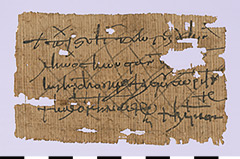SPP III2.5 493 (P. 2675)
Receipts are among the most common types of text that have survived on papyrus. Naturally, the Berlin Papyrus Collection also possesses many of these mostly very short and dry texts. Yet they contain a great deal of information, as can be seen from the papyrus presented here.
This papyrus is quite well preserved in its original margins. The Greek text on the small sheet is almost complete. Only at the end of the second line several letters have been lost through a hole in the papyrus. It was probably found in the Fayum, an oasis southwest of Cairo, and came into the Berlin Papyrus Collection between 1877 and 1881. Based on the writing, the text can be dated to the 7th to 8th century and thus belongs to a time when Egypt had already been conquered by the Arabs and was part of the Caliphate.
The text is a receipt confirming to a certain Konstantinos that he had delivered wheat. About Konstantinos we learn that he was a scribe. Much more is said about the delivery of the wheat. First of all, the quantity is given: two artabs of wheat in a so-called kankellon-measure are acknowledged. An artab is an ancient unit of measurement used in Egypt at that time. It corresponds to about 30 kg. In contrast, the exact meaning of the kankellon-measure is rather unclear. It probably derives from a similar-sounding Persian unit of measurement for grain and was used in Egypt, especially in Arab times, as a measure for tax grain.
And the reason for Konstantinos’ delivery of wheat is a tax payment. This is not only evident from the mention of the unfortunately not more precisely localisable place Lenos in the Fayum, for which the grain was delivered, but above all from the indication of the tax year. Thus, we learn that the wheat was delivered for the 15th year of the indiction. The indiction was a 15-year cycle for counting the fiscal years that had been used since the 4th century in the Roman Empire and thus also in Egypt. The years within the cycle were simply numbered consecutively. The people of that time were of course aware of the year of indiction in which they were living. However, a conversion to the calendar used today is impossible without further clues. At least we learn from the receipt that the wheat was delivered on the 16th of Pachon. That corresponds to 11 May.
The wheat delivery was confirmed by the tax collector Georgios, who also wrote the receipt. Numerous other receipts have been preserved from him, which today are summarised as Georgios‘ dossier. In the last line, two of Georgios‘ colleagues confirm the wheat delivery with their signatures: Kalomenas and Elias. They also appear on other receipts.
However, the papyrus still has a small peculiarity. It can be seen very clearly that the entire text has been crossed out by intersecting diagonal lines. This was intended to mark the invalidation of the receipt. Apparently, the wheat delivery receipt was transferred to a tax register, so that the text presented here lost its actual value.
Another papyrus in the Berlin Papyrus Collection confirms another wheat delivery by Konstantinos on the same day for the same village. However, it was now three artabs. Why two receipts were issued for the total of five artabs of wheat is unclear. Perhaps Konstantinos brought the wheat in two instalments.



